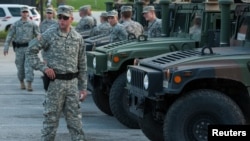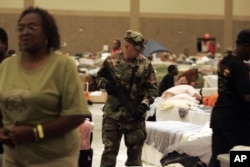With violent protests continuing in Ferguson, Missouri, nine days after an unarmed black man was shot by a white police officer, the state’s governor on Monday called in the National Guard.
Governor Jay Nixon’s decision came as an unofficial autopsy report released by the family of Michael Brown found that Brown, 18, had at least six bullet wounds from the August 9 incident.
That shooting resulted in days of riots, looting and clashes with law enforcement, violence that prompted two nights of curfews over the weekend and widespread criticism of the police response. Police officials have said the officer, Darrell Wilson, shot Brown during a nighttime scuffle.
While Nixon’s decision indicated concern that violence was spiraling out of hand, National Guard deployments for civil unrest in the U.S. are uncommon.
It wasn’t immediately clear how many troops would be sent, nor what their exact duties would be, though Nixon did say that some would be protecting a police command center.
In the United States, around 460,000 so-called “citizen soldiers” serve in National Guard units across all 50 states, the District of Columbia and U.S. territories, according to the National Guard Association of the United States, a lobbying group. Around two-thirds serve in the Army National Guard; about 106,000 in the Air National Guard.
Typically, guard assignments range from supporting law enforcement to, more commonly, helping clean up after natural disasters.
In 2005, Louisiana and other Gulf Coast states called in National Guard units to help in the aftermath of deadly Hurricane Katrina and its flooding and mayhem. In drought-stricken Western states, they’re battling wildfires. In flood-prone areas, they fill and stack sandbags.
Earlier this month, Texas Gov. Rick Perry called up about 1,000 National Guard troops to patrol the border with Mexico amid an influx of young child migrants.
National Guard units, however, are increasingly called up for national defense, as well. Several states’ Air National Guard wings helped patrol U.S. air space in the aftermath of the terrorist attacks of September 11, 2001.
More than half of all Guard members have been deployed to Iraq and Afghanistan – sometimes multiple times – as well as other foreign locations, according to John Goheen, spokesman for the National Guard Association.
“What the National Guard offers governors – in the case of Ferguson or fighting wildfires – is units of disciplined, uniformed personnel,” he said. They “can be quickly trained to do things, to carry out missions.”
There are federal law enforcement agencies: the FBI being the best known example. But, as Steven P. Bucci, a retired Army colonel who is currently an analyst at the Heritage Foundation, pointed out, the United States, unlike most countries around the world, doesn’t have a national police force.
Instead, he said, “we’ve given that power through our constitution to the governors and the mayors, all the way down.”
Federal mobilizations
For now, the presence of the Missouri’s National Guard in Ferguson is strictly a state affair, authorized by the governor under state laws. That conceivably could change if the situation were to worsen.
“The use of the National Guard, even in state status, to quell civil disturbances is usually a last resort and not very common,” Charles J. Dunlap, a Duke University law professor, told VOA in an email interview.
On Monday, President Barack Obama said that his attorney general, Eric Holder, would be traveling to the St. Louis suburb to meet with federal investigators looking into the shooting.
One extreme possibility—something, no one appears to be discussing at this moment— would be for the federal government to step in and take control of the guard.
At least one 19th century federal law provides the legal basis for that, along with the 1952 Armed Forces Reserve Act, which, among other things, enables the federal government to supersede a governor’s authority and take control of the National Guard for a specific mission – a relatively rare act.
Since World War II, presidents have “federalized” National Guard for domestic law enforcement missions 10 times. The most recent example came in 1992 when the acquittal of four white police officers, charged with brutally beating a black man in Los Angeles, California, sparked widespread riots and looting.
The decision to call in the Guard for law enforcement— state or federal—is fraught, given the constitutional and statutory restrictions that restrict the U.S. armed forces from having domestic police duties.
“Although the U.S. military is generally prohibited from exercising domestic law enforcement authority, a state National Guard unit may do so unless it’s called to federal service,” said Dunlap, who is also a retired Air Force major and former deputy judge advocate general. State law defines its exact law enforcement authority.
Here, from the National Guard Bureau, are some notable examples of National Guard deployments in U.S. history that were later “federalized”:
1957-58 – Little Rock, Arkansas President Dwight D. Eisenhower orders the takeover of National Guard troops that had been called up by Gov. Orval Faubus to keep black students from attending Little Rock’s all-white Central High School. Eisenhower also deployed U.S. marshals and paratroopers from the 101st Airborne Division to assist in maintaining order after rioting broke out.
1962 – Oxford, Mississippi After the University of Mississippi in Oxford flouts a court order and bars a black student from attending classes there, President John F. Kennedy federalizes Mississippi National Guard troops to prevent violence toward the student, James Meredith, and rioting in the broader community.
1963 – Tuscaloosa, Alabama A year after Oxford, Alabama Gov. George Wallace physically blocks black students from entering a University of Alabama at Tuscaloosa building, despite a court order. That prompts President Kennedy to take control of the Alabama National Guard to enforce the court order allowing black students to enroll.
1965 – Selma, Alabama President Lyndon B. Johnston federalizes the Alabama National Guard to protect peaceful protesters marching from Selma to Montgomery to protest racial discrimination. At an earlier march, protesters were brutally beaten by state police and deputies.
1968 – Detroit, Michigan; Chicago, Illinois; Washington, D.C. Johnson orders deployment of thousands of National Guard units from those two states, and the federal district, to patrol streets and prevent rioting that erupted after the assassination of civil rights leader Martin Luther King, Jr.
1970 – New York City After thousands of postal workers walked off the job, President Richard M. Nixon orders thousands of National Guard troops to help deliver the mail in the city’s financial district. Others sort mail and keep picketers from interfering.
1992 – Los Angeles, California Rioting erupts in Los Angeles after four white police officers are acquitted in the brutal beating of Rodney King, a black man. President George H. W. Bush calls up more than 10,000 California National Guard troops to help quell the unrest.
VOA's Mike Eckel contributed to this report.










